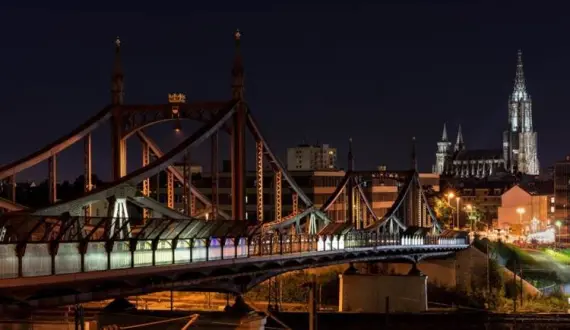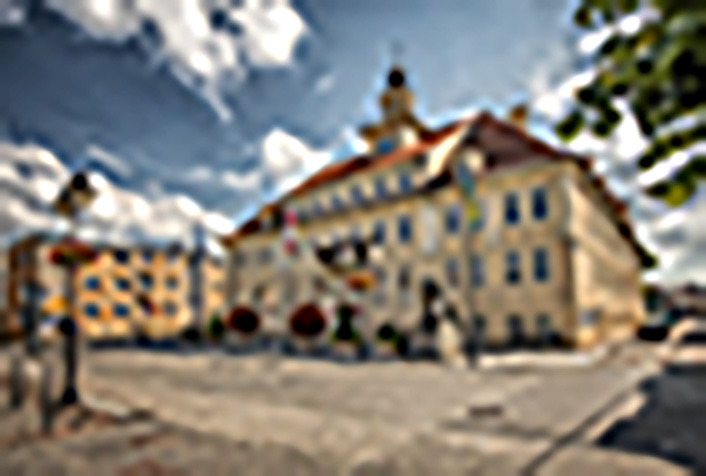Bus to OLSZTYNEK from ULM - buy a ticket
ULM

Ulm is a city on the Danube River in the German state of Baden-Württemberg in the south of the country. It has a long history - in sources the name "Ulma" appears as early as 856, and Ulm has had city rights since 1181. Walking around the city, one can see a successful mix of historical buildings and modern, also very futuristic buildings.
The largest monument here is the Gothic cathedral, famous for having the world's tallest tower. From it you can enjoy views of the immediate and somewhat distant environs of Ulm. Attractions in the city include the Fischerviertel - the Fishermen's Quarter stretching along the banks of the Danube. Here you can stroll along narrow, cobblestone streets amid charming little houses. One of them, known as Schiefes Haus, or the late Gothic "crooked house," is deflected from the vertical by about 10° due to the rather sodden ground. Ulm offers a large number of cultural events with the most famous one, the Danube Festival, at the top, many theaters, art galleries and interesting museums like the Bread and Art Museum. While you're here, be sure to stop by Germany's largest botanical garden, run by the University of Ulm. It covers an area of 28 hectares and showcases vegetation from all of Earth's climatic zones. Friedrichsau Park, with its small lakes and picnic areas, will also be a good place for a stroll in the city.
Getting to Ulm - bus, plane, car or train?
Ulm is included in a low-emission zone, which means you need an environmental sticker from all vehicles entering the city. The international airports closest to it are in Stuttgart and Munich. Ulm's main train station is located near the old town. Our coaches stop at the bus station in the Böfingen district. If you are interested in the sights and attractions of Ulm, don't wait to plan your trip with us!
Ulm is a city on the Danube River in the German state of Baden-Württemberg in the south of the country. It has a long history - in sources the name "Ulma" appears as early as 856, and Ulm has had city rights since 1181. Walking around the city, one can see a successful mix of historical buildings and modern, also very futuristic buildings.
The largest monument here is the Gothic cathedral, famous for having the world's tallest tower. From it you can enjoy views of the immediate and somewhat distant environs of Ulm. Attractions in the city include the Fischerviertel - the Fishermen's Quarter stretching along the banks of the Danube. Here you can stroll along narrow, cobblestone streets amid charming little houses. One of them, known as Schiefes Haus, or the late Gothic "crooked house," is deflected from the vertical by about 10° due to the rather sodden ground. Ulm offers a large number of cultural events with the most famous one, the Danube Festival, at the top, many theaters, art galleries and interesting museums like the Bread and Art Museum. While you're here, be sure to stop by Germany's largest botanical garden, run by the University of Ulm. It covers an area of 28 hectares and showcases vegetation from all of Earth's climatic zones. Friedrichsau Park, with its small lakes and picnic areas, will also be a good place for a stroll in the city.
Getting to Ulm - bus, plane, car or train?
Ulm is included in a low-emission zone, which means you need an environmental sticker from all vehicles entering the city. The international airports closest to it are in Stuttgart and Munich. Ulm's main train station is located near the old town. Our coaches stop at the bus station in the Böfingen district. If you are interested in the sights and attractions of Ulm, don't wait to plan your trip with us!
OLSZTYNEK

Olsztynek is a town in northeastern Poland, located in the Warmian-Masurian Voivodeship, Olsztyn County. It is a picturesque town with a rich history that serves as an important regional center in this part of the country.
Olsztynek is located in the central part of Warmia and Mazury, in a region of exceptional natural beauty. The town is close to lakes, forests and agricultural land, making it an attractive place for both living and tourism. In addition, Olsztynek lies about 25 kilometers from Olsztyn, the province's capital, providing easy access to the larger urban center.
Olsztynek has a long history, dating back to the Middle Ages. There are many historical monuments in the town center, such as the Church of St. Thomas the Apostle, which is one of the most important religious buildings in the region. Also worth noting is the Folk Building Museum, which showcases the region's traditional architecture and rich cultural heritage.
Olsztynek is well connected to the larger cities of the region, including Olsztyn, making it an attractive place to live for those working in the province's capital. The town is close to major national roads, providing convenient access to other parts of Warmia and Mazury and to other regions of Poland.
Olsztynek is a town in northeastern Poland, located in the Warmian-Masurian Voivodeship, Olsztyn County. It is a picturesque town with a rich history that serves as an important regional center in this part of the country.
Olsztynek is located in the central part of Warmia and Mazury, in a region of exceptional natural beauty. The town is close to lakes, forests and agricultural land, making it an attractive place for both living and tourism. In addition, Olsztynek lies about 25 kilometers from Olsztyn, the province's capital, providing easy access to the larger urban center.
Olsztynek has a long history, dating back to the Middle Ages. There are many historical monuments in the town center, such as the Church of St. Thomas the Apostle, which is one of the most important religious buildings in the region. Also worth noting is the Folk Building Museum, which showcases the region's traditional architecture and rich cultural heritage.
Olsztynek is well connected to the larger cities of the region, including Olsztyn, making it an attractive place to live for those working in the province's capital. The town is close to major national roads, providing convenient access to other parts of Warmia and Mazury and to other regions of Poland.
© 2025 Sindbad
Technical support, assistance, payments: Sindbad IT
© 2025 Sindbad
Technical support, assistance, payments: Sindbad IT
